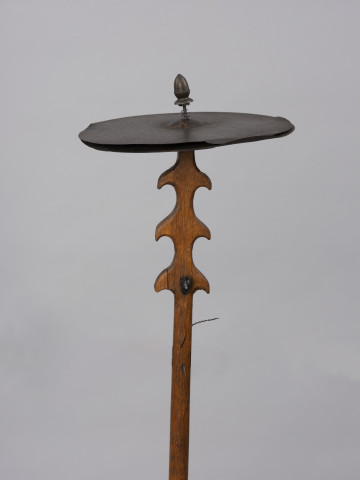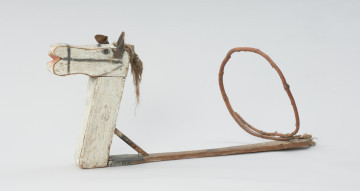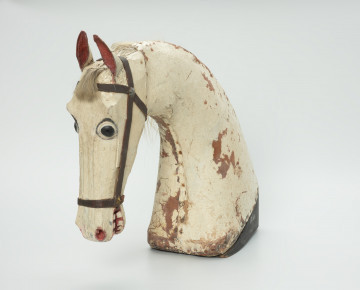
Bladder fiddle (Deil's fiddle)
1901 — 1945
National Museum in Szczecin
Part of the collection: Material culture of West Pomerania
The goat was one of the characters in groups of carol singers who, during Christmas and carnival, visited houses to wish their inhabitants good luck. The goat was played by a boy covered with a cloth sheet, holding a stick topped with a realistically sculpted goat head, usually made of wood. The animal was accompanied by three human characters – an Old Man, a Jew and a Gypsy. After being let into the room, the goat became the main character in the performed scene. It would jump playfully around, teasingly strike girls with its horns, frighten children while its companions boldly proclaimed: “Where the goat walks, rye is born,/ Where the goat tracks – hills are raised,/ Where the goat turns its horns – hay rises”. In folk beliefs, the goat symbolised prosperity and also fertility, both in terms of the land, animals as well as people. At some point, the goat would fall to the ground pretending to be dead, and then was “brought back to life” by one of its companions. “Resurrection” would cause general joy and enthusiasm because it gave hope that, just like the dead animal, nature stagnant during the winter would come back to life and produce crops. The goat on display from the ethnographic collection of the National Museum in Szczecin comes from the first half of the 20th century. It was made of wood using a woodworking method. Painted black, the animal’s head is realistically depicted, with visible eyes, nostrils and a slightly opened snout. The goat has ears made of leather and massive, backwards-curving horns placed on the top of its head, as well as a beard made of horse(?) hair. It was originally in the collection of the Pommersches Landesmuseum Stettin.
Agnieszka Słowińska
Author / creator
Dimensions
cały obiekt: height: 31,4 cm, width: 25 cm
Creation time / dating
Creation / finding place
Identification number
Location / status

1901 — 1945
National Museum in Szczecin

1. połowa XX wieku
National Museum in Szczecin

1. połowa XX wieku
National Museum in Szczecin
DISCOVER this TOPIC
Museum of King Jan III's Palace at Wilanów
DISCOVER this PATH
Educational path